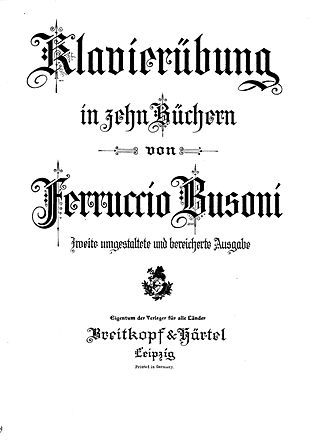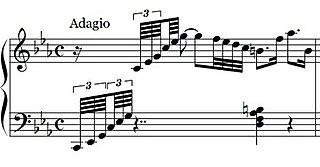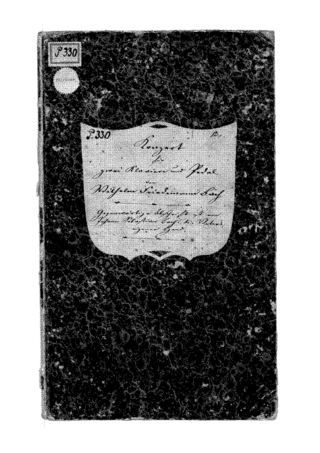
The Piano Sonata No. 11 in A major, K. 331 / 300i, by Wolfgang Amadeus Mozart is a piano sonata in three movements.

Ludwig van Beethoven's Piano Sonata No. 29 in B♭ major, Op. 106 is a piano sonata that is widely viewed as one of the most important works of the composer's third period and among the greatest piano sonatas of all time. Completed in 1818, it is often considered to be Beethoven's most technically challenging piano composition and one of the most demanding solo works in the classical piano repertoire. The first documented public performance was in 1836 by Franz Liszt in the Salle Erard in Paris to an enthusiastic review by Hector Berlioz.

The Cello Sonata No. 1 in E minor, Op. 38, entitled "Sonate für Klavier und Violoncello", was written by Johannes Brahms in 1862–65.

The Fantasy on Themes from Mozart's Figaro and Don Giovanni, S.697, is an operatic paraphrase for solo piano by Franz Liszt, based on themes from two different Mozart's operas: The Marriage of Figaro, K.492 and Don Giovanni, K.527.

Piano Sonata No. 13 in E-flat major, Op. 27 No. 1, "Quasi una fantasia", is a sonata composed by Ludwig van Beethoven in 1800–1801.

Ludwig van Beethoven's Piano Sonata No. 30 in E major, Op. 109, composed in 1820, is the third-to-last of his piano sonatas. In it, after the huge Hammerklavier Sonata, Op. 106, Beethoven returns to a smaller scale and a more intimate character. It is dedicated to Maximiliane Brentano, the daughter of Beethoven's long-standing friend Antonie Brentano, for whom Beethoven had already composed the short Piano Trio in B♭ major WoO 39 in 1812. Musically, the work is characterised by a free and original approach to the traditional sonata form. Its focus is the third movement, a set of variations that interpret its theme in a wide variety of individual ways.

The Piano Sonata No. 14 in C minor, K. 457, by Wolfgang Amadeus Mozart was composed and completed in 1784, with the official date of completion recorded as 14 October 1784 in Mozart's own catalogue of works. It was published in December 1785 together with the Fantasy in C minor, K. 475, as Opus 11 by the publishing firm Artaria, Mozart's main Viennese publisher.
Fantasia No. 3 in D minor, K. 397/385g is a piece of music for solo piano composed by Wolfgang Amadeus Mozart in 1782. Despite the fact it was finished by another composer, the piece is nonetheless one of his more popular compositions for the piano.

Wolfgang Amadeus Mozart's Piano Sonata No. 1 in C major, K. 279 / 189d (1774), is a piano sonata in three movements. It was written down, except for the first part of the opening movement, during the visit Mozart paid to Munich for the production of La finta giardiniera from late 1774 to the beginning of the following March. It is the first of his 18 piano sonatas. A typical performance of the sonata takes about 14 minutes.
The Sonatas for cello and piano No. 4 in C major, Op. 102, No. 1, and No. 5 in D major, Op. 102, No. 2, by Ludwig van Beethoven were composed simultaneously in 1815 and published, by Simrock, in 1817 with a dedication to the Countess Marie von Erdődy, a close friend and confidante of Beethoven.

The Klavierübung, by the Italian pianist-composer Ferruccio Busoni, is a compilation of piano exercises and practice pieces, comprising transcriptions of works by other composers and original compositions of his own.
"Làcidaremla mano" is a duet for the characters Don Giovanni (baritone) and Zerlina (soprano) in Mozart's 1787 opera Don Giovanni.

The Bach-Busoni Editions are a series of publications by the Italian pianist-composer Ferruccio Busoni (1866–1924) containing primarily piano transcriptions of keyboard music by Johann Sebastian Bach. They also include performance suggestions, practice exercises, musical analysis, an essay on the art of transcribing Bach's organ music for piano, an analysis of the fugue from Beethoven's 'Hammerklavier' sonata, and other related material. The later editions also include free adaptations and original compositions by Busoni which are based on the music of Bach.

The Twelve Grand Concertos, Op. 6, HWV 319–330, by George Frideric Handel are concerti grossi for a concertino trio of two violins and cello and a ripieno four-part string orchestra with harpsichord continuo. First published by subscription in London by John Walsh in 1739, they became in a second edition two years later Handel's Opus 6. Taking the older concerto da chiesa and concerto da camera of Arcangelo Corelli as models, rather than the later three-movement Venetian concerto of Antonio Vivaldi favoured by Johann Sebastian Bach, they were written to be played during performances of Handel's oratorios and odes. Despite the conventional model, Handel incorporated in the movements the full range of his compositional styles, including trio sonatas, operatic arias, French overtures, Italian sinfonias, airs, fugues, themes and variations and a variety of dances. The concertos were largely composed of new material: they are amongst the finest examples in the genre of baroque concerto grosso.
The Musette, or rather chaconne, in this Concerto, was always in favour with the composer himself, as well as the public; for I well remember that HANDEL frequently introduced it between the parts of his Oratorios, both before and after publication. Indeed no instrumental composition that I have ever heard during the long favour of this, seemed to me more grateful and pleasing, particularly, in subject.

Fantasia No. 2 in C minor, K. 396/385f is a fragment of a violin sonata composed by Wolfgang Amadeus Mozart in Vienna in August or September 1782.

The Chromatic Fantasia and Fugue in D minor, BWV 903, is a work for harpsichord by Johann Sebastian Bach. Bach probably composed it during his time in Köthen from 1717 to 1723. The piece was already regarded as a unique masterpiece during his lifetime. It is now often played on piano.

The six sonatas for violin and obbligato harpsichord BWV 1014–1019 by Johann Sebastian Bach are works in trio sonata form, with the two upper parts in the harpsichord and violin over a bass line supplied by the harpsichord and an optional viola da gamba. Unlike baroque sonatas for solo instrument and continuo, where the realisation of the figured bass was left to the discretion of the performer, the keyboard part in the sonatas was almost entirely specified by Bach. They were probably mostly composed during Bach's final years in Cöthen between 1720 and 1723, before he moved to Leipzig. The extant sources for the collection span the whole of Bach's period in Leipzig, during which time he continued to make changes to the score.

The organ sonatas, BWV 525–530 by Johann Sebastian Bach are a collection of six sonatas in trio sonata form. Each of the sonatas has three movements, with three independent parts in the two manuals and obbligato pedal. The collection was put together in Leipzig in the late 1720s and contained reworkings of prior compositions by Bach from earlier cantatas, organ works and chamber music as well as some newly composed movements. The sixth sonata, BWV 530, is the only one for which all three movements were specially composed for the collection. When played on an organ, the second manual part is often played an octave lower on the keyboard with appropriate registration. Commentators have suggested that the collection might partly have been intended for private study to perfect organ technique, some pointing out that its compass allows it to be played on a pedal clavichord. The collection of sonatas is generally regarded as one of Bach's masterpieces for organ. The sonatas are also considered to be amongst his most difficult compositions for the instrument.

The organ concertos of Johann Sebastian Bach are solo works for organ, transcribed and reworked from instrumental concertos originally composed by Antonio Vivaldi and the musically talented Prince Johann Ernst of Saxe-Weimar. While there is no doubt about the authenticity of BWV 592–596, the sixth concerto BWV 597 is now probably considered to be spurious. Composed during Bach's second period at the court in Weimar (1708–1717), the concertos can be dated more precisely to 1713–1714.
Franz Schubert composed his Fantasy in C major for violin and piano, Op. posth. 159, D 934, in December 1827. It was the last of his compositions for violin and piano, and was premiered in January 1828 by the violinist Josef Slavik and the pianist Carl Maria von Bocklet at the Landhaussaal in Vienna.

















